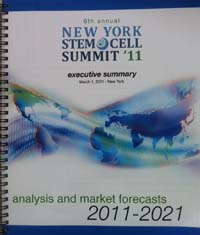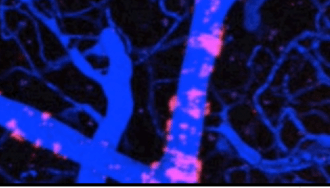
Robin Young’s 6th annual Stem Cell Summit was held on March 1, 2011 in NYC. In attendance were scores of public and private stem cell companies. Presentations included: 21 adult stem cell companies, 3 embryonic companies, 7 device/ instrumentation companies, and a panel of medical experts discussing Spinal Cord Injury. Each company gave a 10-15 minute presentation.
For the past few years, Arnold Caplan, Ph.D, a leader in the world of stem cell therapy, has presented the keynote address to the conference. Dr. Caplan is professor of biology at Case Western and has authored more than 300 publications. Not only is he well known in academic circles, but he is no stranger to the biotech financial community, as he was the founder of Osiris Therapeutics (Nasdaq: OSIR), a publicly traded cell therapy company. According to his own disclosures, Dr. Caplan no longer has financial ties with Osiris, but he is involved with other cell therapy start ups. Here are some highlights from Caplan’s keynote entitled, The State of MSCs in 2011.
Changing the way we think about stem cells
“We are in a new era of how we should be thinking about stem cells.” Dr. Caplan described that we should think of the stem cell industry in two realms:
- Tissue Engineering
- Regenerative Medicine
He emphasized that the first phase of the cell therapy revolution has been focused on tissue engineering, whose main premise is using manufacturing processes to make stem cells differentiate into various lineages like bone, heart, or brain. However, Dr. Caplan proposed that the next phase of the cell therapy movement, known as ‘regenerative medicine’, will come from natural healing responses from the stem cell, not from the actual differentiation of stem cells into various cell lineages.
adipose tissue is an enormously potent source of autologous regenerative therapy.
More specifically, the REGEN revolution will come from your body’s own natural healing response which occurs when stem cells mechanically separate from blood vessels and release therapeutic molecules that your body takes cues from. Caplan stated that therapeutic uses would come from both cultured and uncultured stem cell sources, and cited uncultured adipose tissue as a potent source of autologous regenerative therapy.
What are Mesenchymal Cells (MSCs)?
Mesenchymal stem cells, also known as MSCs, are specific cells within a population of stem cells with certain surface markers. These “MSCs are the cells that are doing all the business of healing”. Dr. Caplan described how Mesenchymal cell population is largely a function of the number of blood vessels.

The natural niche of mesenchymal cells is within the blood vessel wall. Thus, the more blood vessels, the more MSCs – and vice versa. In the scientific community, this thesis is largely expressed as: All MSCs are pericytes. Recent publications by Dr. Caplan have been devoted to this theme of how all MSCs are pericytes and helps one understand why stem cells provide vascularity to damaged tissue. In simplified terms–they are a source of vascularity or blood supply.
How do you activate MSCs?
MSCs are attached to the blood vessels. According to Dr. Caplan, the healing mesenchymal cells activate when they become detached from the blood vessel wall. This can occur with mechanical force, chemical force, or signaling mechanisms. In previous blog posts, we have described some mechanical conditions where MSCs become activated as they detach from the blood vessel wall.
What is magical about MSC activation?
When MSCs detach from the blood vessel wall they release a TON of cytokines and growth factors that, in essence, become a personalized drug store for your own body. What this means is that Big Pharma may need to rethink how they are doing things and get onboard the REGEN train.
The arrogance of bone marrow
Caplan recounted how bone marrow had been the de facto source of mesenchymal adult stem cells for decades. As was mentioned earlier, Dr. Caplan was involved in one of the first cell therapy start ups–Osiris. Dr. Caplan said that it always bothered him that “even though stem cells could be derived from other sources such as muscle, fat, heart, and brain- these other sources went largely ignored for years.”
Adipose fat has 300-500 fold more stem cells compared to bone marrow.
In a moment of jest, he referred to “the arrogance of those working with bone marrow.” Caplan explained that “as it turns out, the winner of MSC population is adipose tissue” explaining that per ml, adipose fat tissue has 300-500 fold number of healing mesenchymal stem cells compared to bone marrow. Adipose tissue can be derived from liposuctioned fat. He also detailed that a concentrated pellet of uncultured fat tissue, known as the stromal vascular fraction (SVF) of adipose tissue, is an ‘enormously potent source of autologous stem cell therapy’.
Existing Clinical Trials using MSCs
Dr. Caplan listed the many diseases which are currently in clinical trials with adult stem cell therapy. It’s an impressive list to say the least:
|
|
Potential treatment of sepsis
When the body doesn’t respond to antibiotics, a condition called sepsis can occur. This condition causes the body to shut down and often results in loss of peripheral limbs, shock, or even death. Dr. Caplan cited a recent publication which discovered the ability of MSCs to kill gram positive and gram negative bacteria. If this plays out therapeutically, it would mean MSCs could cure sepsis!
MSCs – a new meaning for the acronym
This new era is not about stem cell lineage, but what the stem cell does naturally in different tissue environments. Since MSCs are therefore site regulated, natural multi-drug delivery systems, they essentially become your body’s personal drug store. Dr. Caplan then proposed the following:
MSC = Mesenchymal Stem Cell => for tissue engineering
MSC = Medicinal Signalling Cells => for REGEN industry
Considering Dr. Caplan’s history, this promises to be a very interesting era for medicine and health care! We welcome your comments about this fantastic new era of regenerative medicine.




Ralph says:
Dr. Ricardo L Rodriguez says:
Jessica Yisca Goldfeld-Katz says:
Dr. Ricardo L Rodriguez says:
Cindy says:
Dr. Ricardo L Rodriguez says:
Surgery says:
Randy Westly says:
Jeffrey Spiegel says:
Dr. Ricardo L Rodriguez says:
MarkTheMeS says:
CosmeticSurg Administrator says:
Surgeon says:
Alexandra Condé Green says: